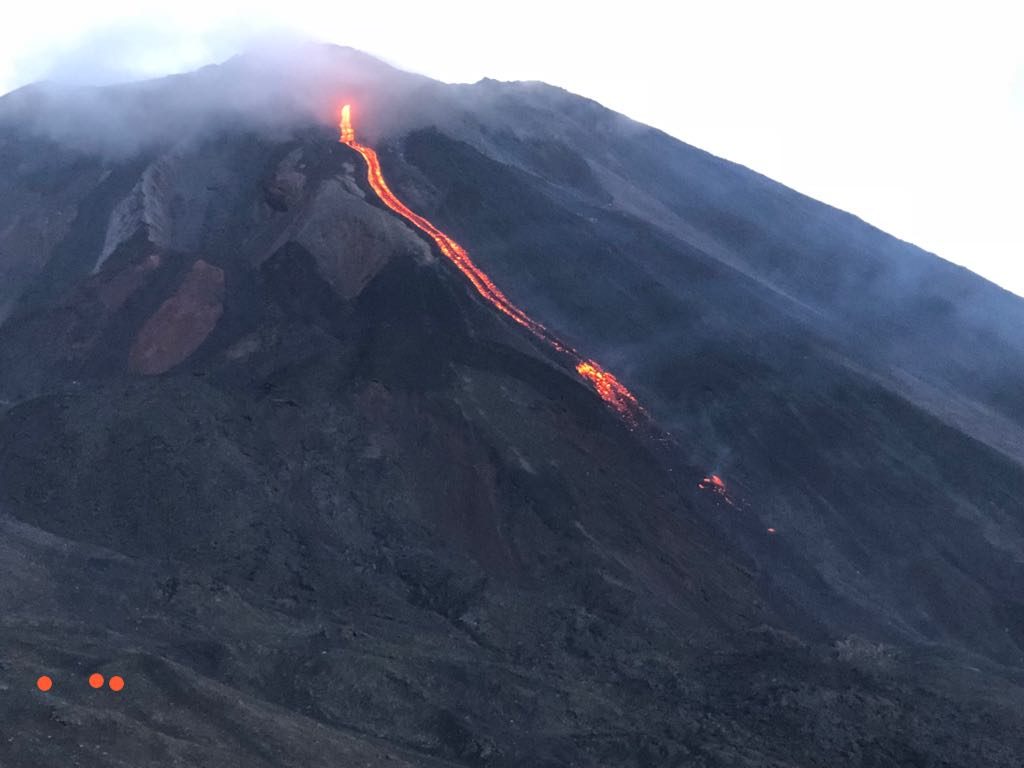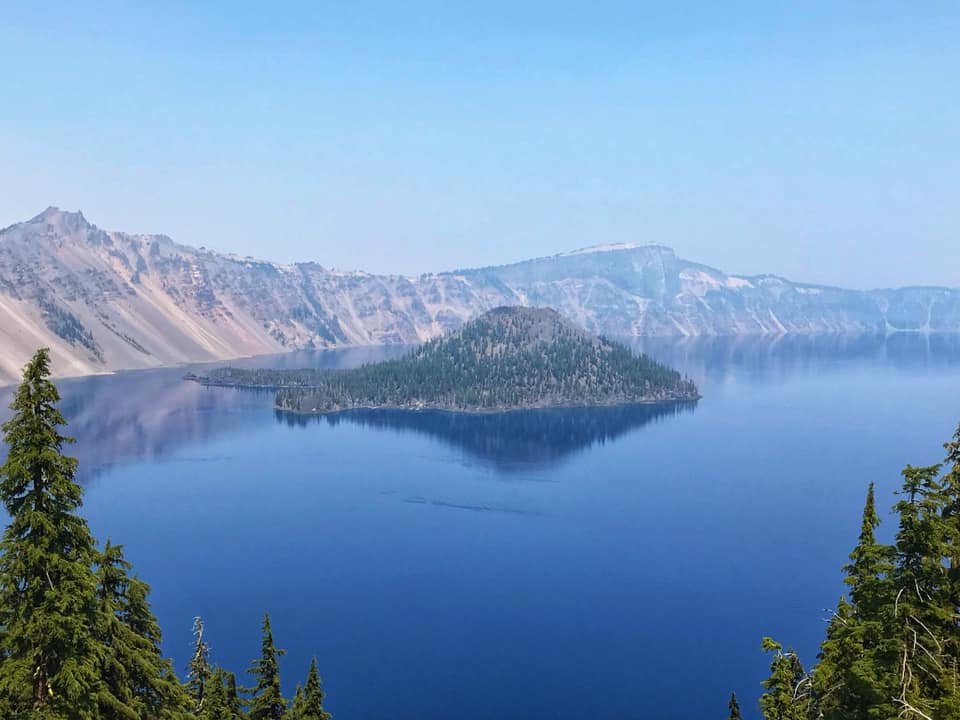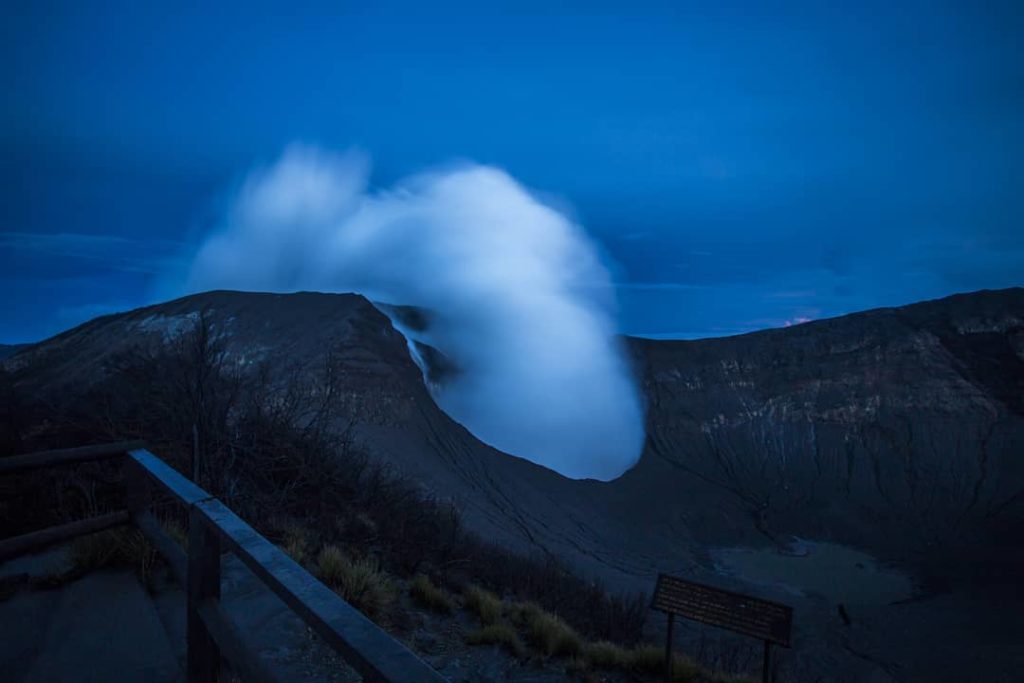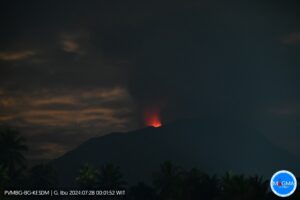June 18 , 2019.
Guatemala , Pacaya :
Type of activity: Strombolian
Morphology: Composite Stratovolcano
Geographical location: 14 ° 22’50˝ Latitude N; 90 ° 36’00˝ Longitude O.
Height: 2,552msnm.
Weather conditions: partly cloudy
Wind: North at 5 km / h
Precipitation: 0.5 mm
Activity:
Presence of white and blue degassing fumaroles rising 200 m above the crater, dispersed to the south. At night and in the early morning, we notice the incandescences of the lava flows towards the North-West. Small avalanches are generated at the front of the stream. Seismic stations record tremors associated with the rise of magma and gases. Strombolian explosions project incandescent material rising 15-25 m above the Mc Kenney crater.
Source : Insivumeh
Photo : tn8.tv
United – States , Crater Lake :
« On June 9, at approximately 1800 UTC (11:00 Pacific) a M1.3 earthquake occurred under Crater Lake at a depth approximately 2 km below sea level. The event was followed by around 2 dozen events over the subsequent 12 hours identified through spectrogram observations. All events are VT in nature. All earthquakes except the first one were clearly observed on only a single station (WIZ- Wizard Island).
Using a single event as a template to search for other similar earthquakes can often detect additional earthquakes not obvious through spectrogram observations. This is called a matched filter approach. Running that analysis on this swarm detects as many as 50 events (cross correlation value >= 0.7).
The most useful interpretation of that result is that all of the observed earthquakes are occurring within a confined space, likely along the same fault patch.
In a strict sense, this sequence is most like a main shock-aftershock sequence, which would argue for the source to be fault slip on a regional fault.
Digging through the logs, the last mention of a swarm was in May 2015 w/ 4+ VT earthquakes (none located). Prior to that, in April 2014 there was around 20 VT earthquakes (4 located) at about the same depth and location. In October 2014, there were 3 VTs that were not located, but had a P-S time on WIZ that is consistent with the current swarm. All this to say that the source region that we see in this earthquake may be the same one seen during the two swarms in 2014. »
Source : USGS / Crater Lake National Park
Photo : Tatiana DeLeon
Costa Rica , Turrialba / Poas :
Daily report of the state of volcanoes. OVSICORI-UNA
Date: June 17, 2019
Updated at: 10:42:00 AM.
Turrialba Volcano:
No eruption is reported.
The seismic activity is similar to that of yesterday.
At the time of this report, the winds blow from the northwest.
Degassing is maintained, mainly consisting of water vapor.
Poas Volcano:
No eruption is reported.
https://www.facebook.com/OVSICORI/videos/2477844232501915/
The seismic activity is similar to that of yesterday.
At the time of writing, winds are blowing from the northeast.
When the weather permits, there is a degassing in the aerial fumaroles of the volcano and in the lake that covers the mouth A (old dome).
Source : OVSICORI.
Video : OVSICORI , Mars 2019.
Photo : auteur inconnu
Italy , Campi Flegrei :
Better than diamonds! Rare minerals at the Solfatara of Pozzuoli. by Massimo Russo
The Pozzuoli Solfatara is a volcanic crater of the Campi Flegrei Caldera, famous worldwide for its hottest fumaroles in the region and for the variety of minerals associated with them. But another reason of interest to the mineralogists lies in the fact that, here, three new species of minerals have been discovered for the first time in the world: Dimorphine, Voltaiite and Russoite, the latter being presently exclusively here. In the phlegrean volcano, Dimorphin and Russianite are present only in the crater fumarole at the highest temperature, Bocca Grande (T = about 160 ° C), while Voltaiite was found in a cave, collapsed in the 1980s, whose fumaroles had a temperature close to 100 ° C.
The systematic study of the minerals of the Solfatara of Pozzuoli began in 1791 with Scipione Breislak, geologist and naturalist Roman; previously, sulfur, realgar, chlorammonium, and alum were already known. The turning point of knowledge occurred with Arcangelo Scacchi, who recounted his observations in the works of 1841 and 1849, then with Antonio Parascandola, in 1951. The contributions of the authors quoted appear in the bibliography attached. Nowadays, the NAPOLITAN section of the INGV Osservatorio Vesuviano, in collaboration with the Department of Chemistry of the University of Milan, continued its research on the solid phases found at the emission points of fumaroles, using the instruments more modern available for processing and mineralogical analysis. The techniques used are different: for example, X-ray diffractometry (XRD), both powder minerals and single crystals, to identify the species present, and the scanning electron microscope (SEM), to perform morphological investigations. crystals. The SEM can be equipped with an energy dispersive spectrometer (EDS), which allows a basic chemical analysis of solid substances.
Let’s look at these three minerals closely:
Dimorphin (dimorphite) – arsenic sulphide, chemical formula As4S3 – is a sublimate and was first discovered in the world by Arcangelo Scacchi in 1849. It was called dimorphin because it appeared in two different crystallizations; recently, more than 160 years after its discovery, it was found in the fumarole called Bocca Grande (Figure 1).
Figure 1 – Dimorphine (dimorphite – As4S3). It is in the form of very bright lemon yellow crystals, not exceeding one millimeter, in the fumarole of Bocca Grande (photo by Maurizio Torre). In the frame, the same mineral observed at the SEM (photograph of Italo Campostrini).
Russosite – whose chemical formula is (NH4) ClAs2O3 (H2O) 0.5 – is another sublimate. This species was only identified for the first time in the world in 2015, in the Bocca Grande. The recognition of the new mineral was approved by the International Mineralogical Association (IMA) in 2016 (Figure 2). At present, no discovery is known in other parts of the world. The species has this name because its discoverers dedicated it to the author of this article.
Figure 2 – Russoite [(NH4ClAs2O3 (H2O) 0.5]] It appears as colorless or slightly yellowish crystals, with a hexagonal habit at once simple (not larger than 0.4 mm) and rarely grouped in a « rosette », in the Bocca Grande fumarole (photograph by Massimo Russo) In the frame, the same mineral observed at SEM (photograph by Italo Campostrini).
The third mineral is a fumarolic encrustation, voltaite, whose complex chemical formula is K2Fe2 + 5Fe3 + 3Al (SO4) 12 · 18H2O (Figure 3). It is an uncommon species in Solfatara. It was identified in 1792 by Scipione Breislak, but described for the first time in the world by Arcangelo Scacchi in 1841. The mineral was dedicated to the great Italian physicist Alessandro Volta (1745-1827).
Figure 3 – Voltaite [K2Fe2 + 5Fe3 + 3Al (SO4) 12 · 18H2O]. It is rarely found in small black, cubic, octahedral or cubic-octahedral crystalline aggregates 0.2 mm in size in low temperature fumaroles located in caves at the edge of the crater. In this image, we see it associated with aghiform pickering (MgAl2 (SO4) 4 • 22H2O] (photograph by Massimo Russo). In the frame, the same mineral observed at the SEM (photograph of Italo Campostrini).
Currently, mineral species present in the area of Solfatara and its surroundings (Antiniana and Pisciarelli Agnano) 43 are verified, 13 partially characterized by the lack of available data and others currently under study.
Source : Massimo Russo , INGV Vulcani.
Read the original article : https://ingvvulcani.wordpress.com/2019/06/17/altro-che-diamanti-minerali-rari-alla-solfatara-di-pozzuoli/?fbclid=IwAR1zrabZcd_NHzZalXCSNaeXH5d7sSVyrtDSA8ByWYwl6jV_ZImKvNX2afk










